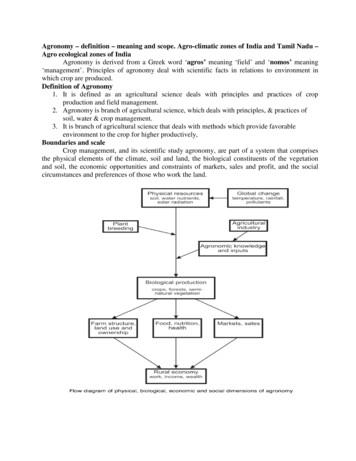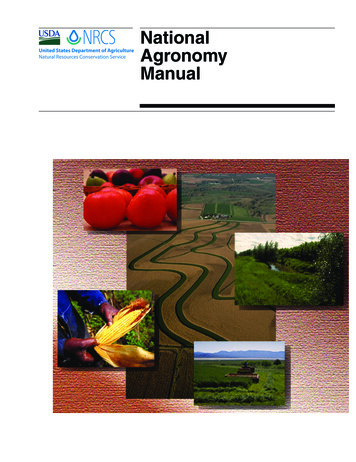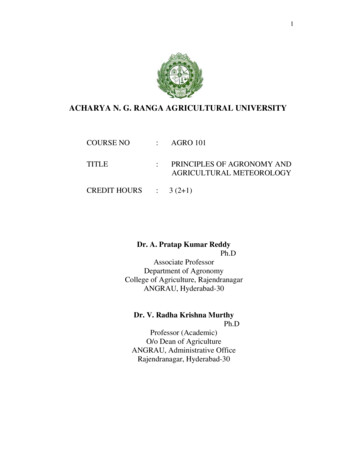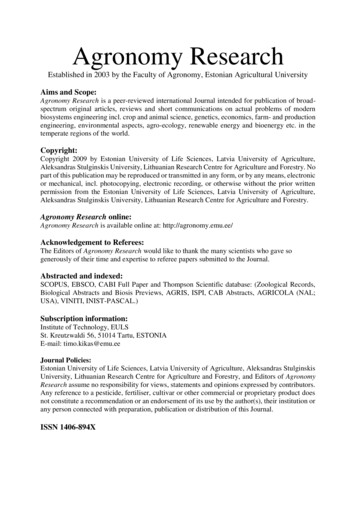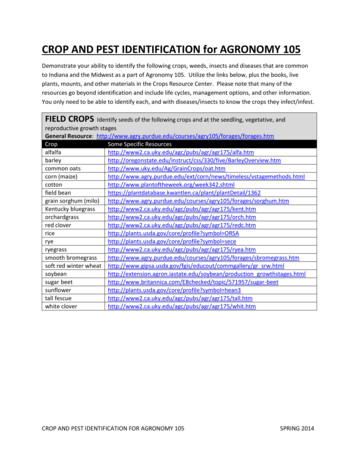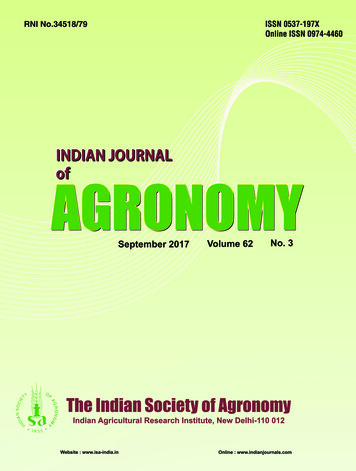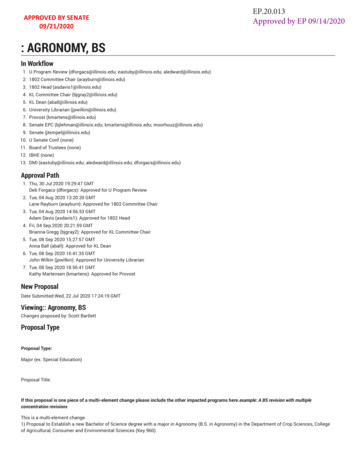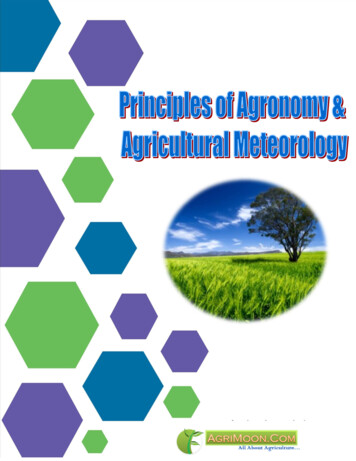
Transcription
Principles of Agronomy & AgriculturalMeteorologyICAR e-CourseForB.Sc (Agriculture) and B.Tech (Agriculture)
IndexSNChapter NamePage No1.Agriculture – Definition – Importance and scope - Branches of agriculture Evolution of man and agriculture – Development of scientific agriculture National and International Agricultural Research Institutes.Indian agriculture - Indian economy – National income – per capita income– Agricultural income in GDP -Women in agriculture and empowermentHistory of agricultural development in the world and India. Agricultureheritage – Agriculture in ancient IndiaStages of agriculture development - Era of civilization- Importance ofNeolithic civilizationChronology of Agricultural technology development in IndiaKautilya’s Arthasasthra - Sangam literature - rainfall prediction – ITK Tamil Almanac.Agronomy – definition – meaning and scope. Agro-climatic zones of Indiaand Tamil Nadu – Agro ecological zones of IndiaCrops and major soils - Classification – Economic and agriculturalimportance in India and Tamil NaduFactors affecting crop production – climatic – edaphic - bioticphysiographic and socio economic factorsTillage – Definition – objectives – types of tillage - modern concepts oftillage – main field preparationSeeds - Seed rate - Sowing methods - Germination - Crop standestablishment - Planting geometryRole of manures and fertilizers in crop production – agronomicinterventions for enhancing FUE - Inter cultivation - Thinning - Gap fillingand other intercultural operationsIrrigation - Time and methods - Modern techniques of irrigation - Drainageand its importancePlanting Geometry and its Effect on Growth and YieldCropping pattern and cropping system - Intensive cropping- Sustainableagriculture – IFSOrganic / eco-friendly agriculture - Dry farming - Concepts and principlesAgro-climatic zones of IndiaAgro meteorologyWeather and climate, micro-climateWeather elements and their influence on different cropsMonsoonCloudsWeather aberrationsWeather forecastingWeather modification -Artificial rain making and cloud seedingRemote 178-184185-189190-199
Lecture -Principles01of Agronomy & Agricultural MeteorologyAgriculture – Definition – Importance and scope - Branches of agriculture - Evolution of manand agriculture – Development of scientific agriculture - National and InternationalAgricultural Research Institutes.AgricultureThe term Agriculture is derived from two Latin words ager or agri meaning soil and culturameaning cultivation. Agriculture is an applied science which encompasses all aspects of cropproduction including horticulture, livestock rearing, fisheries, forestry, etc.Agriculture is defined as an art, science and business of producing crops and livestockfor economic purposes.As an art it embraces knowledge of the way to perform the operations of the farm in askillful manner, but does not necessarily include an understanding of the principles underlying thefarm practices.As a science: utilizes all technologies developed on scientific principles such as cropbreeding, production techniques, crop protection, economics etc. to maximize the yield and profit.For example, new crops and varieties developed by hybridization, Transgenic crop varieties resistantto pests and diseases, hybrids in each crop, high fertilizer responsive varieties, water management,herbicides to control weeds, use of bio-control agents to combat pest and diseases etc.As the business: As long as agriculture is the way of life of the rural population production isultimately bound to consumption. But agriculture as a business aims at maximum net return throughthe management of land labour, water and capital, employing the knowledge of various sciences forproduction of food, feed, fibre and fuel. In recent years, agriculture is commercialized to run as abusiness through mechanization.AGRICULTURE is defined in the Agriculture act (1947), as including ‘horticulture, fruitgrowing, seed growing, dairy farming and livestock breeding and keeping, the use of land as grazingland, meadow land, osier land, market gardens and nursery grounds, and the use of land forwoodlands where that use ancillary to the farming of land for Agricultural purposes”.SCOPE AND IMPORTANCE OF AGRICULTURE IN INDIA AND TAMILNADU With a 16% contribution to the gross domestic product (GDP), agriculture still provideslivelihood support to about two-thirds of country's population. The sector provides employment to 58% of country's work force and is the single largest privatesector occupation. Agriculture accounts for about 15% of the total export earnings and provides raw material to alarge number of Industries (textiles, silk, sugar, rice, flour mills, milk products). Rural areas are the biggest markets for low-priced and middle-priced consumer goods, includingconsumer durables and rural domestic savings are an important source of resource mobilization. The agriculture sector acts as a wall in maintaining food security and in the process, nationalsecurity as well. The allied sectors like horticulture, animal husbandry, dairy and fisheries, have an important rolein improving the overall economic conditions and health and nutrition of the rural masses. To maintain the ecological balance, there is need for sustainable and balanced development ofagriculture and allied sectors.www.AgriMoon.ComPage 4 of 200.1
Principles of Agronomy & Agricultural Meteorology Agriculture’s eyes and minds are soothed by dynamic changes from brown (bare soil) to green(growing crop) to golden (mature crop) and bumper harvests. Plateauing of agricultural productivity in irrigated areas and in some cases the declining trendwarrants attention of scientists.Agriculture helps to elevate the community consisting of different castes and communities toa better social, cultural, political and economical life. Agriculture maintains a biological equilibriumin nature. Satisfactory agricultural production brings peace, prosperity, harmony, health and wealthto individuals of a nation by driving away distrust, discord and anarchy.REVOLUTIONS IN AGRICULTURE Through white revolution, milk production quadrupled from 17 million tonnes atindependence to 108.5 million tonnes. Through blue revolution, fish production rose from 0.75 million tonnes to nearly 7.6 milliontonnes during the last five decades. Through yellow revolution oil seed production increased 5 times (from 5 million tonnes to 25million tonnes) since independence. Similarly, the egg production increased from 2 billion at independence to 28 billion,sugarcane production from 57 million tonnes to 282 million tonnes, cotton production from 3million bales to 32 million bales which shows our sign of progress. India is the largest producer of fruits in the world. India is the second largest producer of milkand vegetable.1.2.3.4.5.6.7.BRANCHES OF AGRICULTURESeven branches viz.,AgronomyHorticultureForestryAnimal husbandryFishery scienceAgricultural Engineering andHome science1) Agronomy – Deals with the production of various crops which includes food crops, fodder crops,fibre crops, sugar, oilseeds, etc. The aim is to have better food production and how to controlthe diseases.2) Horticulture - Deals with the production of fruits, vegetables, flowers, ornamental plants, spices,condiments and beverages.3) Forestry – Deals with production of large scale cultivation of perennial trees for supplying wood,timber, rubber, etc. and also raw materials for industries.4) Animal husbandry – Deals with agricultural practice of breeding and raising livestock in order toprovide food for humans and to provide power (draught) and manure for crops.5) Fishery science – Deals with practice of breeding and rearing fishes including marine and inlandfishes, shrimps, prawns etc. in order to provide food, feed and manure.6) Agricultural Engineering – Deals with farm machinery for filed preparation, inter-cultivation,harvesting and post harvest processing including soil and water conservation engineering andbio-energy.7) Home Science – Deals with application and utilization of agricultural produces in a better mannerin order to provide nutritional security, including value addition and food preparation.On integration, all the seven branches, first three is grouped as for crop production group andnext two animal management and last two allied agriculture branches.www.AgriMoon.ComPage 5 of 200.2
Principles of Agronomy & Agricultural MeteorologyEvolution of man and AgricultureThere are different stages in development of agriculture, which is oriented with humancivilization. They are Hunting Pastoral Crop culture Trade (stages of human civilization).1. Hunting – It was the primary source of food in old days. It is the important occupation and itexisted for a very long period.2. Pastoral – Human obtained his food through domestication animals, e.g. dogs, horse, cow,buffalo, etc. They lived in the periphery of the forest and they had to feed his domesticated animals.For feeding his animals, he would have migrated from one place to another in search of food. It wasnot comfortable and they might have enjoyed the benefit of staying in one place near the river bed.3. Crop culture - By living near the river bed, he had enough water for his animals anddomesticated crops and started cultivation. Thus he has started to settle in a place.4. Trade – When he started producing more than his requirement the excess was exchanged, this isthe basis for trade. When agriculture has flourished, trade developed. This lead to infrastructuredevelopment like road, routes, etc.Agriculture became civilized from crop culture stage. Some important events for differentperiods that lead to development of scientific agriculture.PeriodEventsEarlier than Hunting & gathering10000 BC7500 BCCultivation of crops- Wheat & Barley3400 BCWheel was invented3000 BCBronze used for making tools2900 BCPlough was invented, irrigated farming started2300 BCCultivation of chickpea, cotton, mustard2200 BCCultivation of rice1500 BCCultivation of sugarcane1400 BCUse of iron1000 BCUse of iron plough1500 ADCultivation of orange, brinjal, pomegranate1600 ADIntroduction of several crops to India i.e. potato, tapioca, tomato, chillies, pineapple,groundnut, tobacco, rubber, American cottonDEVELOPMENT OF SCIENTIFIC AGRICULTURE IN WORLDExperimentation technique was started (1561 to 1624) by Francis Bacon. He conducted anexperiment and found that water is the principle requirement for plant. If the same crop is cultivatedfor many times fertility is lost.Jan Baptiste Van Helmont (1572-1644) was actually responsible for conducting a potexperiment. The experiment is called as ‘willow tree experiment’. He took a willow tree of weight 5pounds. He planted in a pot and the pot contained 200 pounds of soil and continuously monitoredfor five years by only watering the plant. By the end of 5th year, the willow tree was weighing 16pounds. The weight of soil is 198 pounds. He concluded that water is the sole requirement forplants. The conclusion was erroneous.In the 18th century, Arthur Young (1741-1820) published ‘Annals of Agriculture’.www.AgriMoon.ComPage 6 of 200.3
Principles of Agronomy & Agricultural MeteorologyIn the beginning of 19 century, scientist Jean Senebier (1742-1809), a Swiss naturalist, ahistorian, gave explanation that increase in the weight of plant was due to the consumption of air.Theodar Desaussure gave the principle theme of photosynthesis.Liebig is a German scientist and considered as the ‘Father of agricultural chemistry’. It washis opinion that the growth of plant was proportional to the amount of mineral substances availablein the soil. This is called as ‘Liebig law of minimum’.thChronological events in scientific agricultureFrancis Bacon (1561-1624 A.D)Found the water as nutrient of plantsG.R.Glanber (1604-1668 A.D)Salt peter(KNO3) as nutrient and not waterJethrotull (1674-1741 A.D)Fine soil particle as plant nutrientPriestly (1730-1799 A.D)Discovered the oxygenFrancis Home (1775 A.D)Thomas Jefferson (1793 AD)Water, air, salts, fire and oil form the plant nutrientsDeveloped mould board ploughTheodore de-SaussureFound that plants absorb CO 2 from air & release O 2 ; soilsupply N 2German chemist developed “law of minimum ”Justus van Liebig (1804- 1873)Advances in Agriculture in 19th Century Following Liebig, an agricultural experiment station was started in Rothamsted in England on1843 (Old Permanent Manurial Experiment – OPME), it dealt with nutrients. Subsequentlymany developments took place. In U.S. land grant colleges was started in 19th century. Itsobjective was to meet the expenditure of the college from the land around the colleges. USDA(United States Department of Agriculture) is responsible for the introduction of herbicides 2,4-Dand tractor combine for harvesting and threshing. Under Land Grant College, agricultureoriented teaching, research, extension are expanded. Many international research institutes werestarted for a specific crop. 1857–Michigan State University was established to provide agricultural education at collegelevel. Gregor Mendal (1866) discovered the laws of hereditary. Charles Darwin (1876) published the results of experiments on cross and self fertilization inplants. Thomas Malthus (1898) proposed Malthusian Theory – states that humans would run-out of foodfor everyone inspite of rapid advance in agriculture due to limited land and yield potential ofcrops (i.e food may not be sufficient in future for the growing population at this current rate ofgrowth in agriculture) Blackman (1905) theory of “optima and limiting factors” states that when a process isconditioned as to it’s rapidity by a number of separate factors , the rate of the process is limitedby the pace of the slowest factor” Mitscherlich (1909) proposed the theory of law of diminishing returns that increase in growthwith each successive addition of the limiting element is progressively smaller and the response iscurvilinear. Wilcox (1929) proposed “inverse yield nitrogen law”. It states that the growth or the yieldingability of any crop plant is inversely proportional to the mean nitrogen content in the dry matter.www.AgriMoon.ComPage 7 of 200.4
Principles of Agronomy & Agricultural MeteorologyDEVELOPMENT OF SCIENTIFIC AGRICULTURE IN INDIAScientific agriculture got momentum in the 19th century itself. Indian Land Tax was levied inthe middle of 19th century. In 1877, 1878, 1889, 1892, 1897 and 1900, the population was decreaseddue to continuous famines. Only due to these famines, the British regime started many developmentprogrammes. Lord Dalhousie (1848-1856) period the ‘Upper Bari Doab Canal’ in Punjab wasconstructed. Improvement of agriculture started only in his period. In Lord Curzon’s (1898-1905)period, the ‘Great Canal system of Western Punjab’ was constructed. During his period ImperialAgricultural Research Institute was started in Pusa in Bihar. His period is called as ‘Golden periodof agriculture’. During his regime, Department of Agriculture and Agricultural colleges forprovinces were started at Coimbatore in 1906.Due to earthquake at IARI in Pusa, Bihar it was shifted to New Delhi. In 1926, RoyalCommission on Agriculture was setup and was responsible for giving recommendation to dug canals,lay roads, etc. Based upon the recommendation of Royal Commission, ICAR (Imperial Council ofAgricultural Research) was started in 1929 with the objective to conduct agriculture research. StateAgricultural Universities (SAU) were started after 1960s). ICAR had also started research institutesof its own in different centres in India for various crops.ICAR is the sole body, which controls all the Agricultural Research Institutes in India. Itpaved way for green revolution in India. After 1947, ICAR totally adapted to Land Grant Colleges.In 1962, a Land Grant College was started in Pantnagar (UP). It is the first university with 16,000acres.There are 45 state agricultural universities with research institutes on its own. High yieldingwheat varieties like Kalyansona, Sonalika, Lerma roja and Sonara-64 were introduced. Greenrevolution took in wheat first, next in rice after the invention of Indo-Japanica variety. Today,agricultural research is multi-dimensional. In includes tissue culture, biotechnology besidesbreeding, crop production and crop protection.Milestones1880 - Department of Agriculture was established1903 - Imperial Agricultural Research Institute (IARI) was started at Pusa, Bihar1912 - Sugarcane Breeding Institute was established in Coimbatore1929 - Imperial Council of Agricultural Research at New Delhi (then ICAR) after independencebecomes ICAR1936 - Due to earth quake in Bihar, IARI was shifted to New Delhi and the place was called withoriginal name Pusa1962- First Agricultural University was started at Pantnagar1965-67 - Green revolution in India due to introduction of HYV –Wheat, rice, use of fertilizers,construction of Dams and use of pesticidesIn Tamil Nadu1876 - Madras Agricultural College was established at Saidapet1906 - Agricultural College & Research Institute was established at Coimbatore1971 - Tamil Nadu Agricultural University was startedFor institutes visit http://www.icar.org.in/node/325For state agricultural universities visit Moon.ComPage 8 of 200.5
Principles of Agronomy & Agricultural MeteorologyInstitutions - 451. Central Rice Research Institute, Cuttack2. Vivekananda Parvatiya Krishi Anusandhan Sansthan, Almora3 Indian Institute of Pulses Research, Kanpur4. Central Tobacco Research Institute, Rajahmundry5. Indian Institute of Sugarcane Research, Lucknow6. Sugarcane Breeding Institute, Coimbatore7. Central Institute of Cotton Research, Nagpur8. Central Research Institute for Jute and Allied Fibres, Barrackpore9. Indian Grassland and Fodder Research Institute, Jhansi10. Indian Institute of Horticultural Research, Bangalore11. Central Institute of Sub Tropical Horticulture, Lucknow12. Central Institute of Temperate Horticulture, Srinagar13. Central Institute of Arid Horticulture, Bikaner14. Indian Institute of Vegetable Research, Varanasi15. Central Potato Research Institute, Shimla16. Central Tuber Crops Research Institute, Trivandrum17. Central Plantation Crops Research Institute, Kasargod18. Central Agricultural Research Institute, Port Blair19. Indian Institute of Spices Research, Calicut20. Central Soil and Water Conservation Research & Training Institute, Dehradun21. Indian Institute of Soil Sciences, Bhopal22. Central Soil Salinity Research Institute, Karnal23. ICAR Research Complex for Eastern Region including Centre of Makhana, Patna24. Central Research Institute of Dryland Agriculture, Hyderabad25. Central Arid Zone Research Institute, Jodhpur26. ICAR Research Complex Goa27. ICAR Research Complex for NEH Region, Barapani28. National Institue of Abiotic Stress Management, Malegaon, Maharashtra29. Central Institute of Agricultural Engineering, Bhopal30. Central Institute on Post harvest Engineering and Technology, Ludhiana31. Indian Institute of Natural Resins and Gums, Ranchi32. Central Institute of Research on Cotton Technology, Mumbai33. National Institute of Research on Jute & Allied Fibre Technology, Kolkata34. Indian Agricultural Statistical Research Institute, New Delhi35. Central Sheep and Wool Research Institute, Avikanagar, Rajasthan36. Central Institute for Research on Goats, Makhdoom37. Central Institute for Research on Buffaloes, Hissar38. National Institute of Animal Nutrition and Physiology, Bangalore39. Central Avian Research Institute, Izatnagar40. Central Marine Fisheries Research Institute, Kochi41. Central Institute Brackishwater Aquaculture, Chennai42. Central Inland Fisheries Research Institute, Barrackpore43. Central Institute of Fisheries Technology, Cochin44. Central Institute of Freshwater Aquaculture, Bhubneshwar45. National Academy of Agricultural Research & Management, HyderabadNational Research Centres - 171. National Research Centre on Plant Biotechnology, New Delhi2. National Centre for Integrated Pest Management, New Delhi3. National Research Centre for Litchi, Muzaffarpurwww.AgriMoon.ComPage 9 of 200.6
Principles of Agronomy & Agricultural Meteorology4. National Research Centre for Citrus, Nagpur5. National Research Centre for Grapes, Pune6. National Research Centre for Banana, Trichi7. National Research Centre Seed Spices, Ajmer8. National Research Centre for Pomegranate, Solapur9. National Research Centre on Orchids, Pakyong, Sikkim10. National Research Centre Agroforestry, Jhansi11. National Research Centre on Camel, Bikaner12. National Research Centre on Equines, Hisar13. National Research Centre on Meat, Hyderabad14. National Research Centre on Pig, Guwahati15. National Research Centre on Yak, West Kemang16. National Research Centre on Mithun, Medziphema, Nagaland17. National Centre for Agril. Economics & Policy Research, New DelhiImportant International Institutions on Agricultural ResearchAVRDC- Asian Vegetable Research and Development Centre, TaiwanCIAT – Centro International de Agricultura Tropical , Cali, ColombiaCIP – Centro International da la Papa ( International potato research institute (Lima, Peru, SouthAmerica)CIMMYT – Centro International de Mejoramiento de Maizy Trigo.(International Centre for maizeand Wheat development (Londress, Mexico)IITA –International Institute for Tropical Agriculture, Ibadon in Nigeria, Africa)ICARDA – International Center for Agricultural Research in the Dry Areas (Aleppo, Syria)ICRISAT – International Crops Research Institute for the Semi Arid Tropics (Pattancheru inHyderabad, India)IIMI- International Irrigation Management Institute, Colombo, SRILANKAIRRI – International Rice Research Institute (Los Banos, Philippines)ISNAR- International Service In National Agricultural Research The Hague, NetherlandsWARDA - West African Rice Development Association Ivory coast, Africa.IBPGR - International Board for Plant Genetic Resources, Rome, ItalyCGIAR – Consultative Group on International Agricultural Research, Washington D.CFAO – Food and Agricultural Organization, RomeWMO- World Meteorological Organization, Vienna.www.AgriMoon.ComPage 10 of 200.7
Principles of Agronomy & Agricultural MeteorologyLecture 02Indian agriculture - Indian economy – National income – per capita income – Agriculturalincome in GDP - Women in agriculture and empowermentIndian Agriculture and Economy:Indian Agriculture is one of the most significant contributors to the Indian economy.Agriculture is the only means of living for almost 60% of the employed class in India. Theagriculture sector of India has occupied almost 43% of India's geographical area. Agriculture isstill the only largest contributor to India's GDP (16%) even after a decline in the same in theagriculture share of India. Agriculture also plays a significant role in the growth of socioeconomic sector in India.In the earlier times, India was largely dependent upon food imports, but the successivestory of the agriculture sector of Indian economy has made it self-sufficing in grain production.The country also has substantial reserves for the same. India depends heavily on the agriculturesector, especially on the food production unit after the 1960 crisis in food sector. Since then, Indiahas put a lot of effort to be self-sufficient in the food production and this endeavour of India hasled to the Green Revolution. The Green Revolution came into existence with the aim to improvethe agriculture in India.The services enhanced by the Green Revolution in the agriculture sector of Indianeconomy are as follows: Acquiring more area for cultivation purposes Expanding irrigation facilities Use of improved and advanced high-yielding variety of seeds Implementing better techniques that emerged from agriculture research Water management Plan protection activities through prudent use of fertilizers, pesticides.All these measures taken by the Green Revolution led to an alarming rise in the wheat andrice production of India's agriculture. Considering the quantum leap witnessed by the wheat andrice production unit of India's agriculture, a National Pulse Development Programme that coveredalmost 13 states was set up in 1986 with the aim to introduce the improved technologies to thefarmers. A Technology Mission on Oilseeds was introduced in 1986 right after the success ofNational Pulse Development Programme to boost the oilseeds sector in Indian economy. Pulsestoo came under this programme. A new seed policy was planned to provide entree to superiorquality seeds and plant material for fruits, vegetables, oilseeds, pulses and flowers.www.AgriMoon.ComPage 11 of 200.
Principles of Agronomy & Agricultural MeteorologyThe Indian government also set up Ministry of Food Processing Industries to stimulate theagriculture sector of Indian economy and make it more lucrative. India's agriculture sector highlydepends upon the monsoon season as heavy rainfall during the time leads to a rich harvest. But,the entire year's agriculture cannot possibly depend upon only one season. Taking into account thisfact, a second Green Revolution is likely to be formed to overcome such restrictions. An increasein the growth rate and irrigation area, improved water management, improving the soil quality anddiversifying into high value outputs, fruits, vegetables, herbs, flowers, medicinal plants and biodiesel are also on the list of the services to be taken by the Green Revolution to improve theagriculture in India.National incomeNational Income is important because of the following reasons, To see the economic development of the country. To assess the developmental objectives. To know the contribution of the various sectors to national income.Internationally some countries are wealthy, some countries are not wealthy and somecountries are in-between. Under such circumstances, it would be difficult to evaluate theperformance of an economy. Performance of an economy is directly proportionate to the amountof goods and services produced in an economy. Measuring national income is also important tochalk out the future course of the economy. It also broadly indicates people’s standard of living.Income can be measured by Gross National Product (GNP), Gross Domestic Product (GDP),Gross National Income (GNI), Net National Product (NNP) and Net National Income (NNI).The Indian economy is the 12th largest in USD exchange rate terms. India is the second fastestgrowing economy in the world. India’s GDP has touched US 1.25 trillion. The crossing of IndianGDP over a trillion dollar mark in 2007 puts India in the elite group of 12 countries with trilliondollar economy. The tremendous growth rate has coincided with better macroeconomic stability.India has made remarkable progress in information technology, high end services and knowledgeprocess services.Agricultural income in GDPAgriculture sector contributed 32% in 1990-91, 20% during 2005-06 and around 16% now.Though the contribution of agriculture to the GDP income of India, it is great news that today theservice sector is contributing more than half of the Indian GDP. It takes India one step closer tothe developed economies of the world. Earlier it was agriculture which mainly contributed to theIndian GDP. The Indian government is still looking up to improve the GDP of the country and soPage 12 of 200.www.AgriMoon.Com
Principles of Agronomy & Agricultural Meteorologyseveral steps have been taken to boost the economy. Policies of FDI, SEZs and NRI investmenthave been framed to give a push to the economy and hence the GDP.Agriculture per capita incomeThe per capita income of the agriculture sector declines to 1/3 of the national per capitaincome during the recent years. The per capita income of the agriculture population is estimatedaround Rs. 10,865 in 2010, which is around 32% of the national per capita income at Rs. 33,802/-.Per capita income of the agriculture population was around half (1/2) at Rs. 5,505 of the nationalper capita income at Rs. 11,433/- during 1980 however, it came down to around 42% at Rs.6,652/- of the national per capita income at Rs. 16,020/- during 2000.Income Distribution in Agriculture sectorYear/ PeriodAgriculturePopulation DependentShare in GDPon Agriculture19803970199031652000255920101658Women in Agriculture and empowermentAgriculture Per Capita (in Rs.)4745 (56%)5505 (48%)6652 (42%)10865 (32%)Women in India now participate in all activities such as education, sports, politics, media,art and culture, service sectors, science and technology, etc. Indira Gandhi, who served as PrimeMinister of India for an aggregate period of fifteen years is the world's longest serving womanPrime Minister.The Constitution of India guarantees to all Indian women equality (Article 14), nodiscrimination by the State [Article 15(1)], equality of opportunity (Article 16) and equal pay forequal work [Article 39(d)]. In addition, it allows special provisions to be made by the State infavour of women and children [Article 15(3)], renounces practices derogatory to the dignity ofwomen [Article 51(a) (e)], and also allows for provisions to be made by the State for securing justand humane conditions of work and for maternity relief. (Article 42).The feminist activism in India picked up momentum during later 1970s. Since alcoholism is oftenassociated with violence against women in India, many women groups launched anti-liquorcampaigns in Andhra Pradesh, Himachal Pradesh, Haryana, Orissa, Madhya Pradesh and otherstates. Many Indian Muslim women have questioned the fundamental leaders' interpretation ofwomen's rights under the Shariat law and have criticized the triple talaq system.In 1990s, grants from
1. Agronomy 2. Horticulture 3. Forestry 4. Animal husbandry 5. Fishery science 6. Agricultural Engineering and 7. Home science . 1) Agronomy – Deals with the production of various crops which includes food crops, fodder crops, fibre crops, sugar, oilseeds, etc. The aim is to have bett
